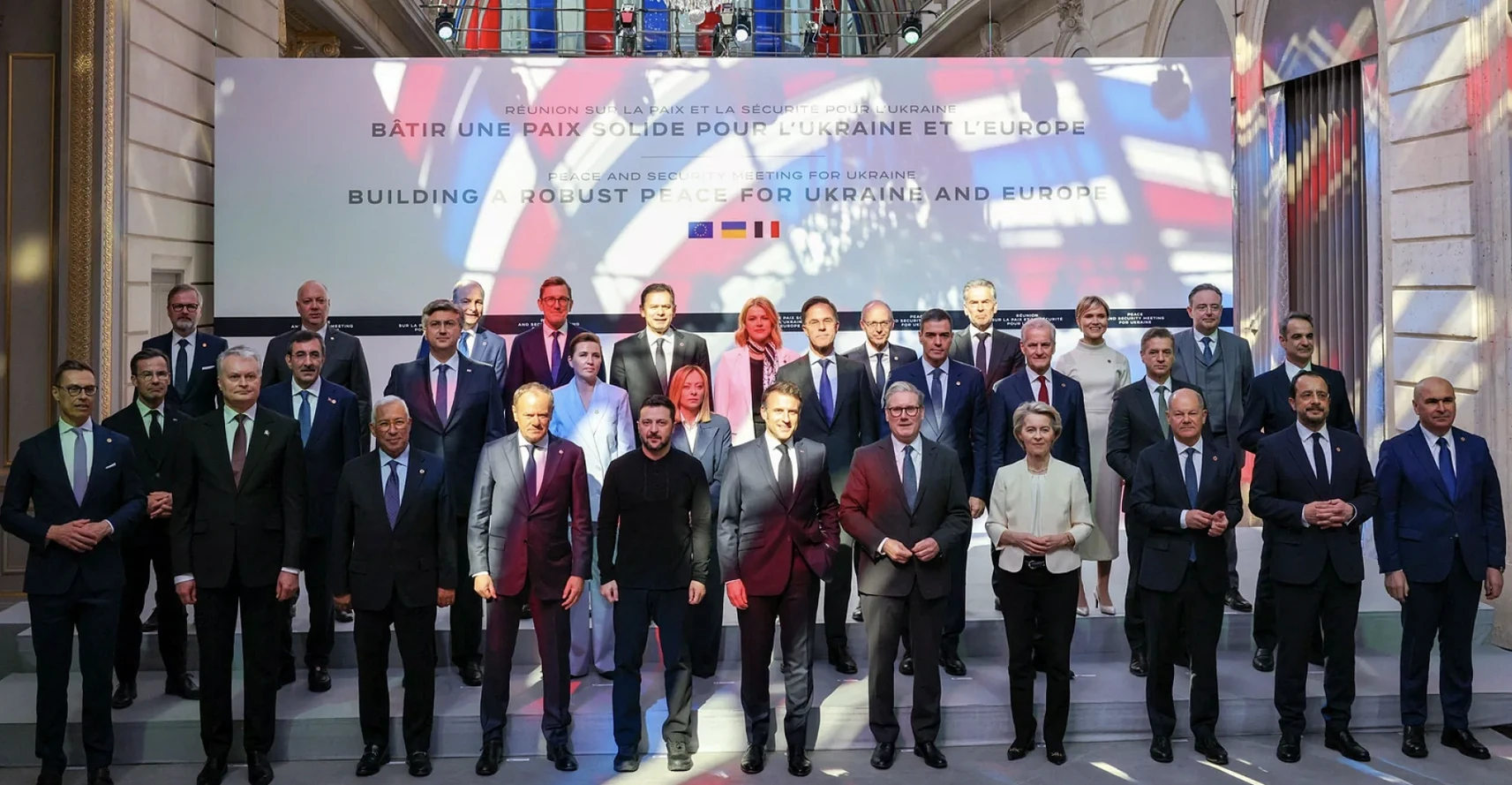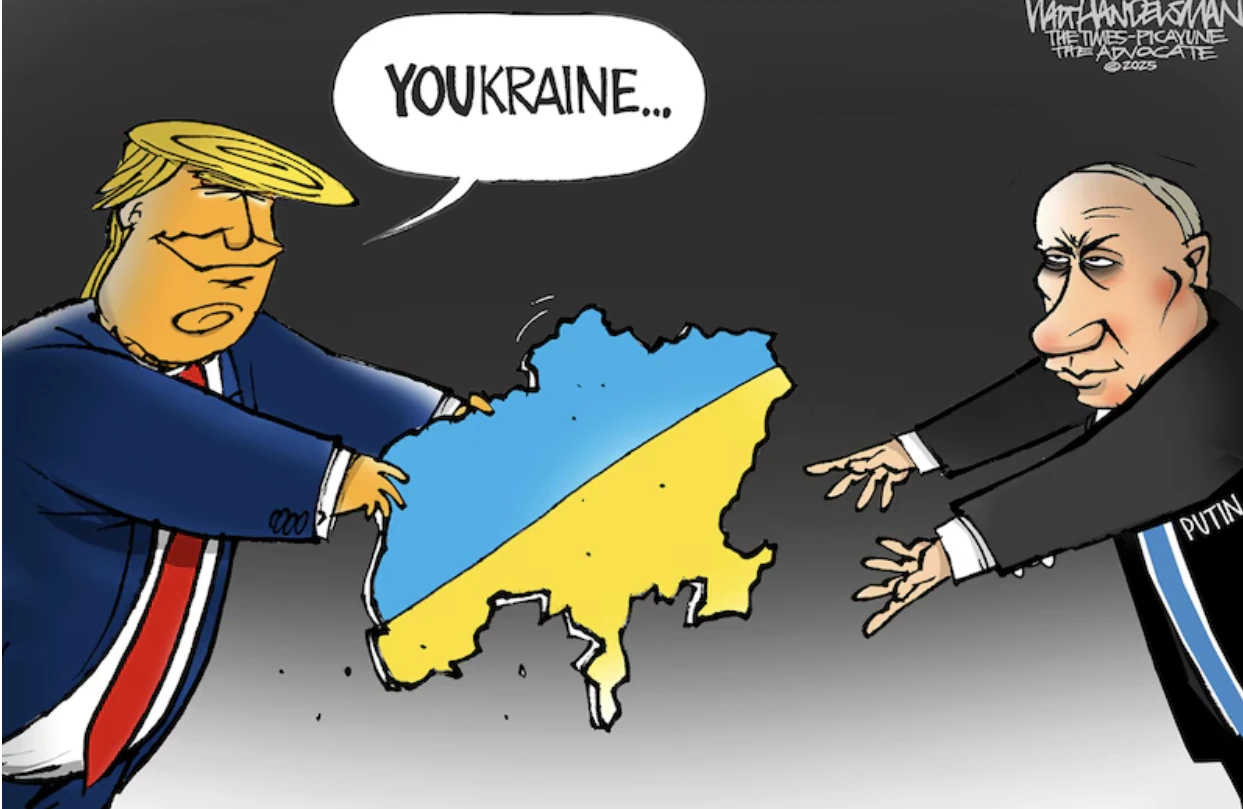“The EU was formed to screw with the United States. That’s the purpose of it. And they’ve done a good job of it. But now I’m President.” ― Donald Trump
On the 27th of March, French President Macron announced a “Coalition of the Willing”, a European “reassurance” force to bolster Ukraine’s defense in the event of a peace deal. The coalition, made up of over 30 countries, plans to be installed similarly to the 1990s NATO peacekeeping model in the Balkans. Small pockets of soldiers spread out around Ukraine’s flank and port cities to keep European troops away from the likely ceasefire line and instead meant to bolster key Ukrainian infrastructure.
The coalition, however, has been called the Coalition of the Waiting by some critics. The EU is terrified of an escalation with Russia, and a common thread with its leaders is a tough but cautious stand towards the imperialist state. The Coalition also relies on the US security umbrella, something the US has recently signaled it isn’t too pleased with. With Washington slowly but surely decreasing its European footprint, Europe must build a strong fighting force not spread out in pockets throughout Europe, but mobile, and ready to deploy wherever Russia may threaten Europe next.
 Copyright European Union, 2025
Copyright European Union, 2025
Parabellum
Si vis pacem, para bellum
If the EU wants to truly build a reassurance force, it will need more than just symbolic troops, far from the front line, that rely on the deus ex machina of the US to provide legitimacy. Skeptics often claim Europe lacks airlift to rapidly redeploy troops around Europe, and cite a lack of manpower in its members' armies. However, most armor is transported via rail, sea, or truck. As Europe sends more money on defense, it seems it will quickly have the capability to field large numbers of soldiers, allowing more flexibility in its military movements.
General Mikhail Kostarakos, the chair of the European Union Military Committee, noted the lack of strategic enablers in Europe. He is referring to things such as air to air refueling, intelligence gathering, satellites, and air and missile defense systems. He echoes concerns many have; that Europe is not capable of defending itself on its own, and needs US backing for legitimacy. However, the EU has spent billions more on defense, with Germany leading the charge. Europe has the tools it needs to defend itself from Russia, and they may be in use in the near future.
Barry R. Posen suggests Europe should fulfill the NATO Readiness Initiative, a proposal from around 2018 which called for the deployment of 30 battalions, 30 squadrons, and 30 ships ready to deploy to Eastern Europe in 30 days. Though the Four 30s never came to be, Europe has more of a reason than ever to ensure its success this time around. Europe collectively has around 100 fighter squadrons, 100 warships, and 100 brigades. It would need only 10 to be able to fulfill the NRI. Europe’s air forces are state of the art, and could easily provide the necessary air support to back up its ground forces.
Ten brigades will not be close to enough to fully counter Russia’s 90 odd regiments. Russian troops are battle-hardened and experienced in modern combat, something that cannot be said for Europe’s forces in kind. Split the EU brigades into two good mechanized corps, however, and suddenly it becomes a significant force that cannot be overlooked. To compare, it would be 2/3rds the size of the force that conquered all of Iraq in 2003. Consolidation of power within EU armies is key for the success of the Coalition. Indeed, this exact method was suggested by NATO towards Ukraine for their Zaporizhzhia offense in 2023, something that Ukrainians ignored. It led to, at best, a pyrrhic victory for Ukraine, a blow which could’ve been dampened significantly.
Europe’s forces are not fully combat-capable yet, however. Equipment is degrading and needs replacement/maintenance. Ammunition and parts for vehicles are not exactly in great supply right now. The EU will also need short range anti aircraft, ready to counter the drones that permeate the war. With Germany’s defense sector roaring to life, and commitments from UK and France however, the three pillars of the EU stand ready to donate supplies, and money, towards the readiness and capability of a united Coalition.
“Speed is the essence of War. Exploit the enemy’s unpreparedness; attack him unawares; take an unexpected route.” ― Sun Tzu, The Art of War
Where will Russia look next? The Eye of Putin could shine its unholy gaze upon the Baltics, or begin to glance at Poland. Who is to say they even take their sight off Ukraine, the breadbasket of Europe? Waiting for the answers to these questions is not an option, Europe must field a battle-ready, speedy set of battalions to be able to answer Russia, wherever in Europe they may strike.
 Ukraine? No, Youkraine.
Ukraine? No, Youkraine.
To do this, the EU must begin setting up the infrastructure in eastern Europe. Bridges in places like Poland are already being reinforced. The EU has spent over 38 billion to upgrade transportation infrastructure. Ports will need to be reinforced as well, and Europe should organize its trucking industry to support military shipping. It will need to install more fiber optic cables, integrate rails from Eastern and Western Europe, and build more fuel tanks. This will ensure the EU has the capability to actually transport the troops, and rapidly.
For the speediness of the Coalition to work, Europe must also consolidate its forces. Without confirmed US assistance, it needs to build its own intelligence and reconnaissance infrastructure. A soldier cannot be deployed if he doesn’t know what he is deploying into. The EU can use the Eurocorps as a foundation of future corps and planning, and use NATO guidelines to enhance the effectiveness of their forces. Europe must stop its long history of military burden sharing, and allow France, Germany, and the UK to take the lead, leveraging the strengths of each nation to ensure a stable, just peace. Europe has the power to take its security in its own hands, and not rely on a fickle American president to decide its fate for them. Now all it needs is the will to actualize it.
“Peacekeeping with American help is old think.” ― Barry R. Posen
For over 60 years, Europe has looked to the US to secure its future. Reliance on NATO made Europe reduce its defense spending, seeing bloody conflict as a thing of the past. The Shadow over Europe was wide, and Europeans felt comfort being in its cool embrace. Now that the Trump administration has decided it resents being the world’s defender, it looks to remove the shade. Europeans must face the sunlight on their own. They’d better buy some sunglasses.
When Macron introduced the Coalition, it sent shockwaves throughout Europe. Not every member was on board with the reassurance force. Polish Prime Minister Donald Tusk confirmed they would not be sending troops to Ukraine, and Giorgia Meloni of Italy declined to participate at all. But countries reluctant to put troops on the ground can instead deploy them to neighboring states. They can also provide intel, ships, aircraft, armor, among other support. With the Franco-British Joint Team headed to Ukraine, the gears are moving, and it is important to allocate the resources of each Coalition member appropriately. The Joint Team already faces delays due to missing US commitments. Stalling for time and shuffling of feet is the worst possible stance to take. Even Neville Chamberlain prepared for war, despite his hopes of a peaceful solution Hitler’s early aggressions.
Diplomats, however, worry about Europe’s readiness without the United States. France is adamant that America is not needed for the Coalition, other members privately worried. Though Washington has opened the door for logistical and intelligence sharing, showing that despite an erratic POTUS, American support may be possible.
Though the US hasn’t pulled out completely, European nations must secure its own future, and indeed, seem to be doing so already. Turkey is ready to assume responsibility in Odessa, one of the flanks covered by the reassurance force. It will keep grain routes open, clear Black Sea mines, and take charge of the international maritime force in the region. France and the UK have sent their joint team, and Poland is helping improve its infrastructure to ensure a speedy Coalition force. The Baltic Trio of Estonia, Latvia, and Lithuania are completely on board with the Coalition. Denmark, Belgium, and the Netherlands are also leaning the right way. Germany is busy building a government, but with Merz signaling his support for Ukraine and the Zeitenwende, it is very likely Berlin will join. The biggest economy and defense sector in Europe is nothing to sneeze at, and will likely encourage other more hesitant states to chip in more.
Even with the US privately signaling security guarantees, Europe’s future is in its own hands. The Trump administration does not seem to care in what state the war ends, and an unjust peace will lead to more war. Washington’s proposal to freeze occupied territories along current battle lines, and the potential legalization of Crimea’s occupation shows its leanings. Europe cannot rely on a fickle Washington, captured by Russia propaganda, to come to its rescue. It must rise to the task, and counter the encroaching Russian threat, ready for action with or without the United States.